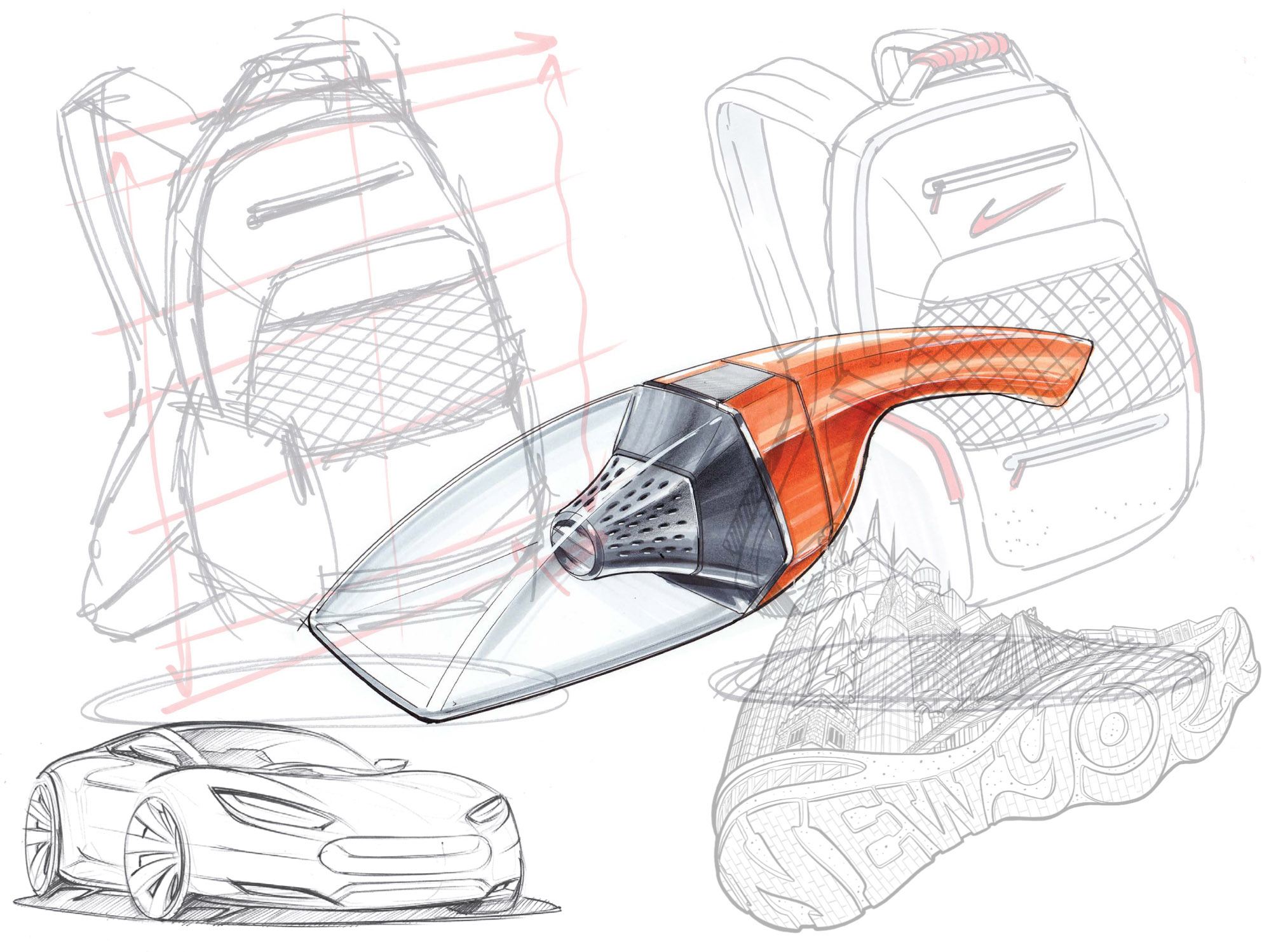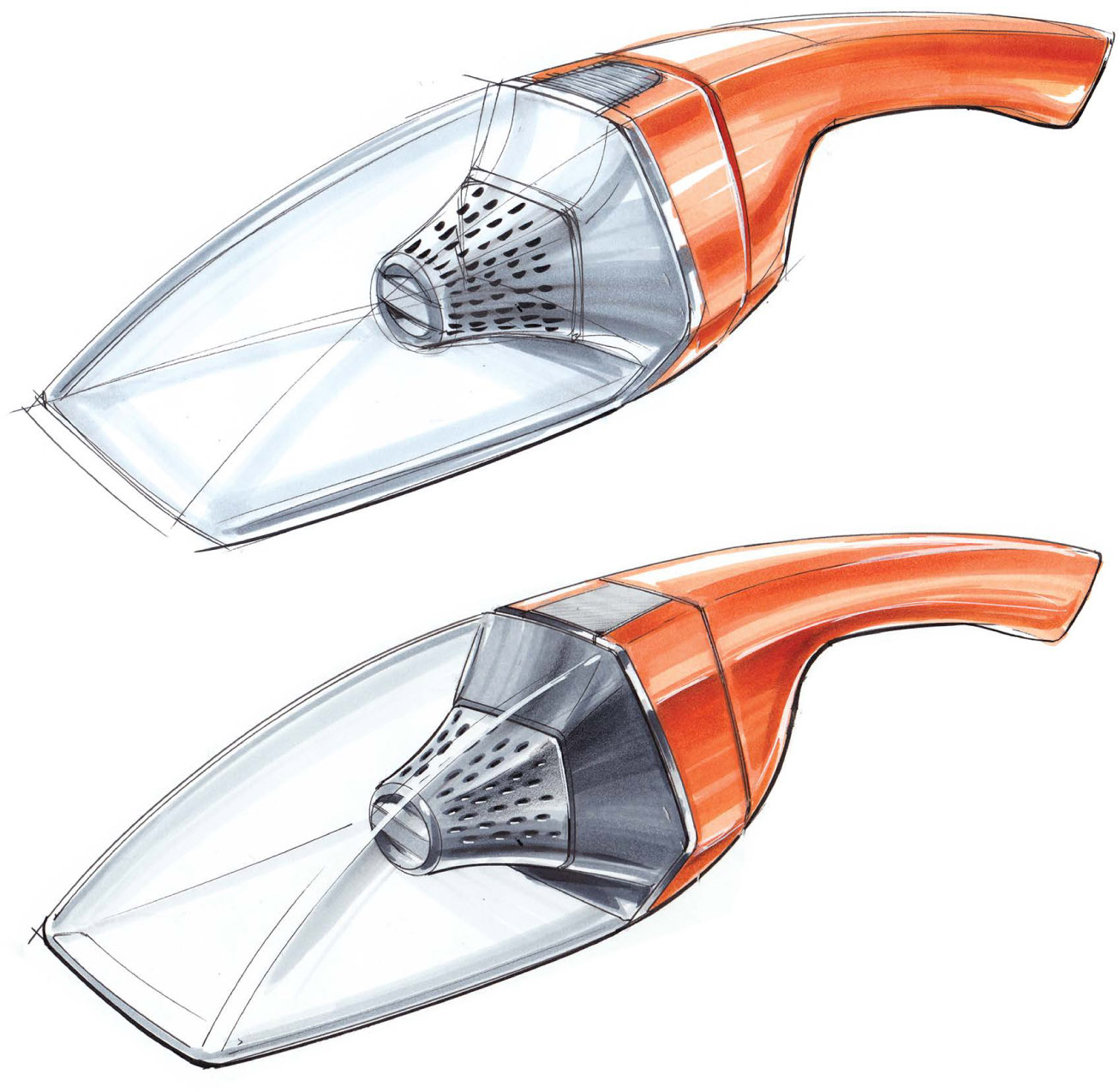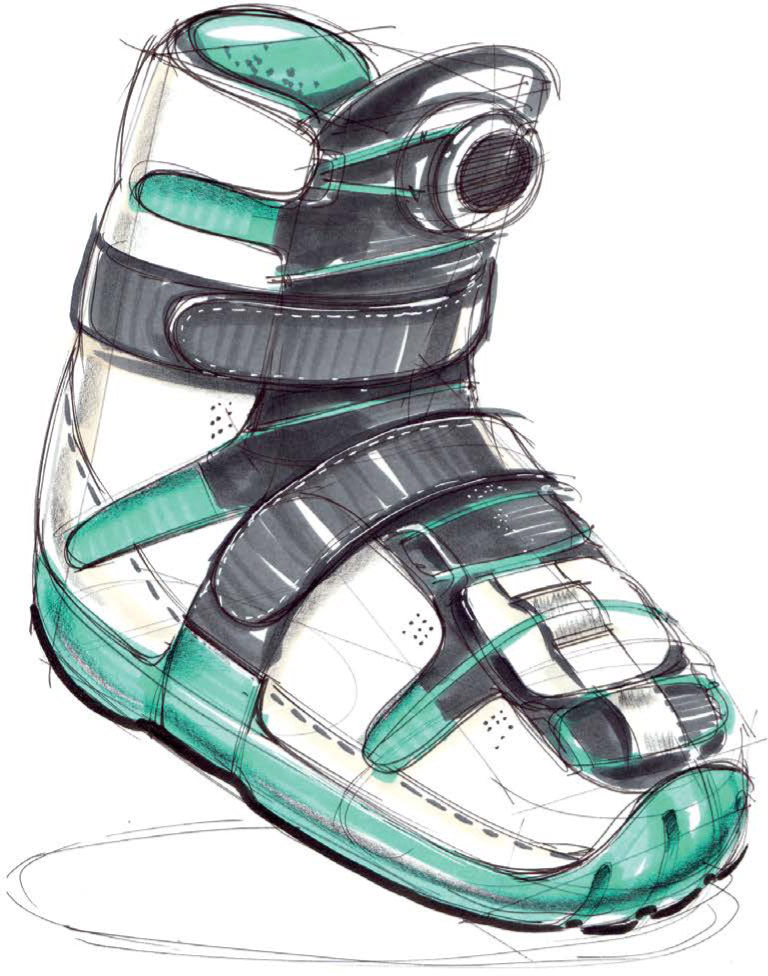
CHAPTER 13 TIGHTEN UP
Although I tend to sketch more loosely and freely when drawing in perspective, at times I need to add a higher degree of precision to a sketch. For quick ideas and concepts sketches in perspective, I tend to leave my line work loosely constructed, as the nature of my work requires balancing speed and efficiency and capturing concepts. For more considered and thought-out drawings, however, tools may be necessary to help increase clarity in a sketch, especially when you need to present a concept to a client or plan to sell or display the artwork. On these occasions, templates, tools, and strategies may be useful for creating tighter sketches and drawings of objects in perspective.
Overlays: Loose but Tight
For a long time in my drawing education, I resisted the idea of overlays. Overlays are simply a way of building on prior work to create an object drawing in accurate perspective. There’s nothing wrong or bad about using overlays when drawing. Just remember that you are building on the work that you created before.

When creating overlays and tightening up drawings, remember to carry through the energy that is inherent to the under-sketch. If you place too much care and concern on the fidelity of the overlay, you may end up with a static and more boring presentation of the object or scene. Be sure to draw with your shoulder and use loose yet expressive and energetic lines when creating the final drawing. Remember, “loose” does not necessarily mean sloppy, imprecise, or thoughtless. Rather, it communicates a level of confidence in your own ability to draw your lines.
Overlays work best when using a paper that is slightly translucent, but having access to translucent paper may not be an option for the final drawing. For example, tracing paper and vellum are cheap papers that are often thin and not always archival. I have drawings from over a decade ago where the inks and pigments in the drawings completed on vellum and tracing paper have bled into the paper and spread over time. It is painful looking back at the time and effort put into those pieces knowing that I could had something much more enduring. While I’m not entirely certain as to the reason for the spread in this case, I do know that certain papers, inks, and media may react adversely with each other. For this reason, having a light table can be a useful tool when creating overlays.

In this example I’m using a light table to reference a previously completed sketch to create a new sketch with differing details. Not only does this allow you to work quickly but it can also help you achieve a higher level of detail than you normally would be able to achieve. You can even use a photo as reference in your overlay process.
Repetitive Strokes
Repetitive strokes are one way to add a level of fidelity to a sketch. Repetitive strokes are executed along the same path in the same fashion as the previous stroke to bolster or refine the resultant line. Repeating a stroke does come with some risk; if your precision and execution are off, it can result in less precise line work that is rough or fuzzy.
Many years ago, I learned an important lesson from a coworker who consistently created tight yet expressive drawings. When I asked what their secret was, they said that they committed to limiting the number of strokes they would use to express a part of the sketch. By counting off one, two, three mentally, they were able to commit to limiting how rough or hairy the resulting lines would be.

So, while my sketches tend to be loose, I try to stick to limiting the number of attempts at communicating a line when drawing. Being able to sketch loosely is a direct outcome of your daily warm-up and sketch practice exercises. The more mileage you log while sketching, the more confident and consistent your sketching will be.
Whole Lines
A slower and more considered drawing can be an effective way to present a final concept, as well. Even though my tendency is to want to preserve the looseness and energetic presentation of objects, you may want to draw more slowly and in a more considered manner, depending on your objective. These slower, more considered drawings tend to be comprised of mostly whole lines that are consistent and well-paced while drawing. The times I find myself using whole lines in a slower fashion tend to be while storyboarding or explaining an experience with multiple panels of illustrations that show interaction and flow with an object.
Whole lines are also well suited for drawing objects for presentation. When presenting an object with whole lines, be aware the drawing may lack some energy and dynamism inherent to sketches constructed more quickly and intuitively. Still, this technique is useful in creating a drawing that feels more deliberate and considered. In this example, I created a conceptual sketch related to shoe culture and the city of New York. Because of the complexity of the drawing, sketching slower than I normally would allowed me to achieve a higher level of detail and crispness in the sketch.

Templates
Adding a few hard, crisp lines and visual elements can help tighten up an overall drawing—especially those destined for presentation or display. As skilled as you might be, there will always be imperfections in drawings when relying on your own motor skills without use of templates. Using an ellipse guide, circle template, French curve, or ruler to create quick, crisp ellipses, curves, or straight lines can really make a noticeable difference in fidelity of the final sketch or drawing. (If templates are cost prohibitive for you, consider using other methods for refining lines, shapes, and color in sketches.)

Compare these two sketches. I did not give the left sketch a tightening pass with a template. For the top sketch, I added a few lines with the help of templates to help refine the presentation.
Peripheral Elements
You can also tighten up a sketch by complementing the sketch itself with more defined elements, such as a background, arrows, text, or other objects that have more precision to them. Adding a background is one of the common ways in which I tighten up a loosely sketched concept for presentation.

Top sketch completed freehand without tools, bottom sketch completed with tools by overlaying rough sketch.
Strategies
When creating a sketch for presentation or a more refined drawing, having a winning strategy that will result in a cleaner drawing is another way to tighten things up. Working with a light pencil sketch or overlay is a common means of planning ahead for a final sketch. Try working rough or lightly before committing to the final sketch. These beginning pencil lines can serve as a guide in creating a tighter sketch as a final drawing. Simply erase your pencil-sketched guides after replacing them with clean line work. This way, the ink line work will show through more than the pencil lines would have. Because the underlying sketch was done in pencil, erasing means that only the ink lines will show through. This method is similar to working with a light gray marker; with marker, however, you lose the ability to erase.
Digital Correction
While digital sketching and drawing are not covered in this book, scanning, or digitizing your work and modifying in the digital environment can help you fix issues with perspective, line quality, and execution. I caution against relying on digital correction, however, as much as I caution against using tools and templates in your regular drawing process. Relying on digital tools can create dependencies that hinder your ability to master drawing with your hand. Given enough experience and understanding, on the other hand, digital tools can help speed up your workflow and level up the fidelity of your drawings.

Original sketch.

Digitally corrected sketch.
Ultimately the purpose of drawing is always communication—whether that communication is emotive, functional, or explanatory. Deciding whether to increase the fidelity of a drawing depends on the purpose of the drawing in the context of how it will be reviewed and understood. It is up to you as the illustrator, designer, or artist to determine what level of fidelity is necessary when presenting sketches and drawings of objects in perspective.
